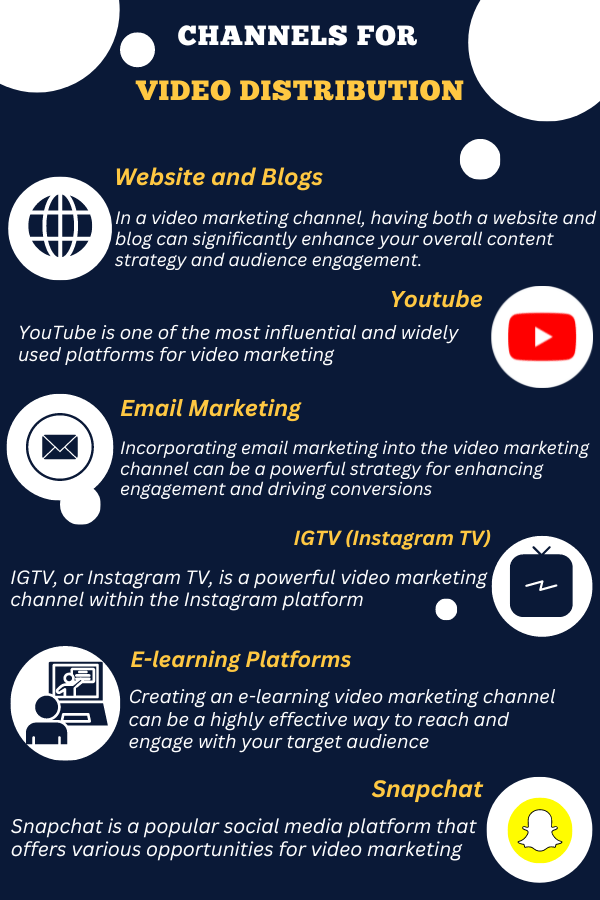Video marketing is a digital marketing tactic that employs video content to advertise brands, products, or services. It uses the visual allure of videos to captivate viewers, effectively communicate ideas, and inspire action. Increasing conversions, fostering engagement, and brand exposure are the objectives. Video marketing comes in various forms and is frequently used on websites that share videos and social media. Comprehending the intended audience, the creation of captivating content, search engine optimization, and analyzing performance metrics are crucial. It’s an effective technique in the digital sphere for making a more meaningful and intimate connection with viewers.
Beyond the fundamentals, this guide uniquely investigates several video formats, state-of-the-art methods, and astute optimization strategies. For data-driven success, learn the art of seamless integration, harness the power of SEO, and ride the analytics wave. Accept a voyage that, via the lens of video marketing, is not only educational but also specially designed to maximize the potential of your business. Welcome to a place where creativity and interaction meet to create a story never seen in the digital content industry.
Importance of video marketing :
Video marketing types :
Video marketing techniques :
Video advertising :
The production and distribution of promotional video content constitutes the digital marketing tactic known as “video advertising.” To reach a specific audience, these videos are positioned strategically across a range of internet channels to showcase goods, services, or brands. By utilizing visual and audio components to draw in and hold viewers’ attention, video advertising takes advantage of the captivating quality of videos to deliver messages more dynamically.
Video marketing SEO and Optimizing :
SEO for video marketing entails improving the visibility of video content. Keyword optimization, exciting images, evocative titles, and transcript provision are all included in this. Improved search rankings result from social media promotion, video sitemaps, and high-quality content. A video marketing strategy must optimize landing pages, ensure they work on mobile devices and track analytics.
Video distribution channels:
Video distribution channels are the platforms or channels through which video material is exchanged and made available to an audience. You must select the appropriate distribution channels to connect with and interest your target audience. Typical video distribution channels are as follows:

Video Marketing Analytics :
Key performance indicators (KPIs) for video marketing analytics include views, watch time, CTR, and conversion rate. Demographic data, traffic sources, and engagement analytics offer insightful information about the target audience. These statistics support strategy optimization, content efficacy measurement, and ROI evaluation of video marketing initiatives.
Video Marketing Measurement :
Monitoring data such as views, watch duration, CTR, and engagement is all part of measuring video marketing. To assess a piece of content’s effectiveness, it is necessary to analyze conversion rates, traffic sources, and demographic information. Gauging the entire effect and success of video marketing initiatives is the aim, along with strategy optimization.
Integrating Video into Marketing Campaigns :
Strategically adding video content to marketing campaigns is one way to improve overall promotional efforts. This can involve using video in email marketing, embedding videos on websites, and making exciting movies for social media. The objective is to use film visual and aural appeal to effectively communicate ideas, boost engagement, and accomplish marketing goals. Across various digital platforms, video integration offers a dynamic and adaptable tool for connecting with and engaging target audiences.
Conclusion :
Video marketing is a dynamic and effective tactic beyond conventional marketing methods. Businesses can effectively engage with their audience by producing exciting content with videos and visual and audio features. Video strategies must be refined through A/B testing and analytics to ensure the best performance and intended outcomes. Videos are a flexible medium for advertising and narrative, whether posted on websites and social media or accessible on platforms like YouTube. Adopting video marketing’s potential is still necessary to stay relevant and leave a lasting impression in the digital world as technology advances.
FAQ’s
What is video marketing so crucial for companies?
Due to its high level of engagement and effectiveness as a means of connecting with people, video marketing is crucial for organizations. Compared to text or image alone, videos may communicate ideas more swiftly and memorably, increasing brand exposure, engagement, and conversions.
What kinds of films ought companies to produce for their marketing campaigns?
Companies have to produce an assortment of movies customized for distinct phases of the client journey. This includes behind-the-scenes movies to humanize the business, training videos to show how to use items, explainer videos to promote goods or services, and promotional videos to highlight special offers or events.
How can companies make sure their films are successful?
Businesses should concentrate on producing high-quality content that is helpful and relevant to their target audience in order to achieve video efficacy. To improve future efforts, it is necessary to measure performance indicators, optimize videos for search engines, employ professional production techniques, develop captivating narrative, and analyze viewer preferences.
Which platforms are best for businesses to post their videos on?
Businesses should release their videos across numerous platforms to attract a bigger audience. This covers well-known social networking sites like Facebook, Instagram, Twitter, and LinkedIn, as well as up-and-coming sites like TikTok and YouTube and Vimeo. They can also increase their reach by including videos into email marketing campaigns and embedding them on their website.
How can companies assess whether their efforts at video marketing are successful?
For their videos to reach a wider audience, businesses should distribute them on a variety of channels. Notable social media platforms include Facebook, Instagram, Twitter, LinkedIn, and TikTok, in addition to more recent platforms like YouTube and Vimeo. Adding videos to email marketing campaigns and embedding them on their website are further ways they can expand their audience.

